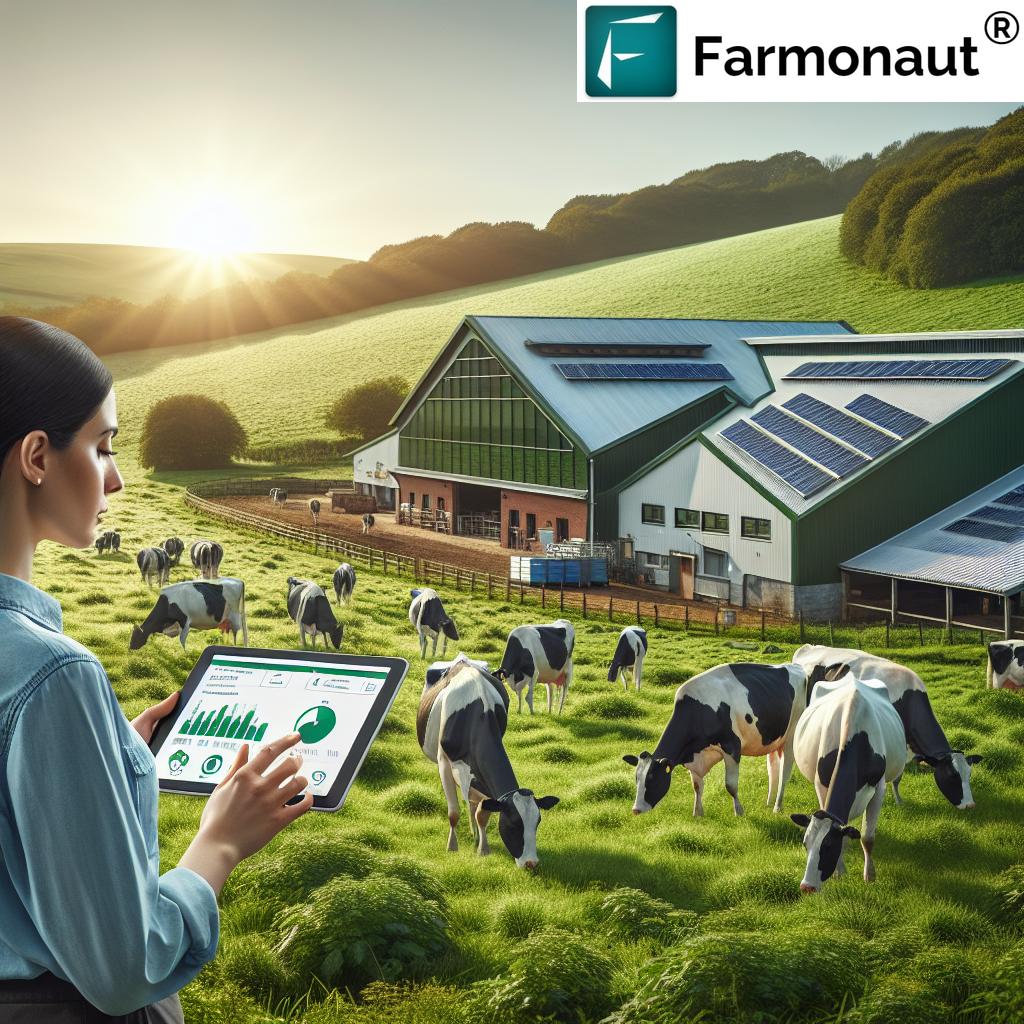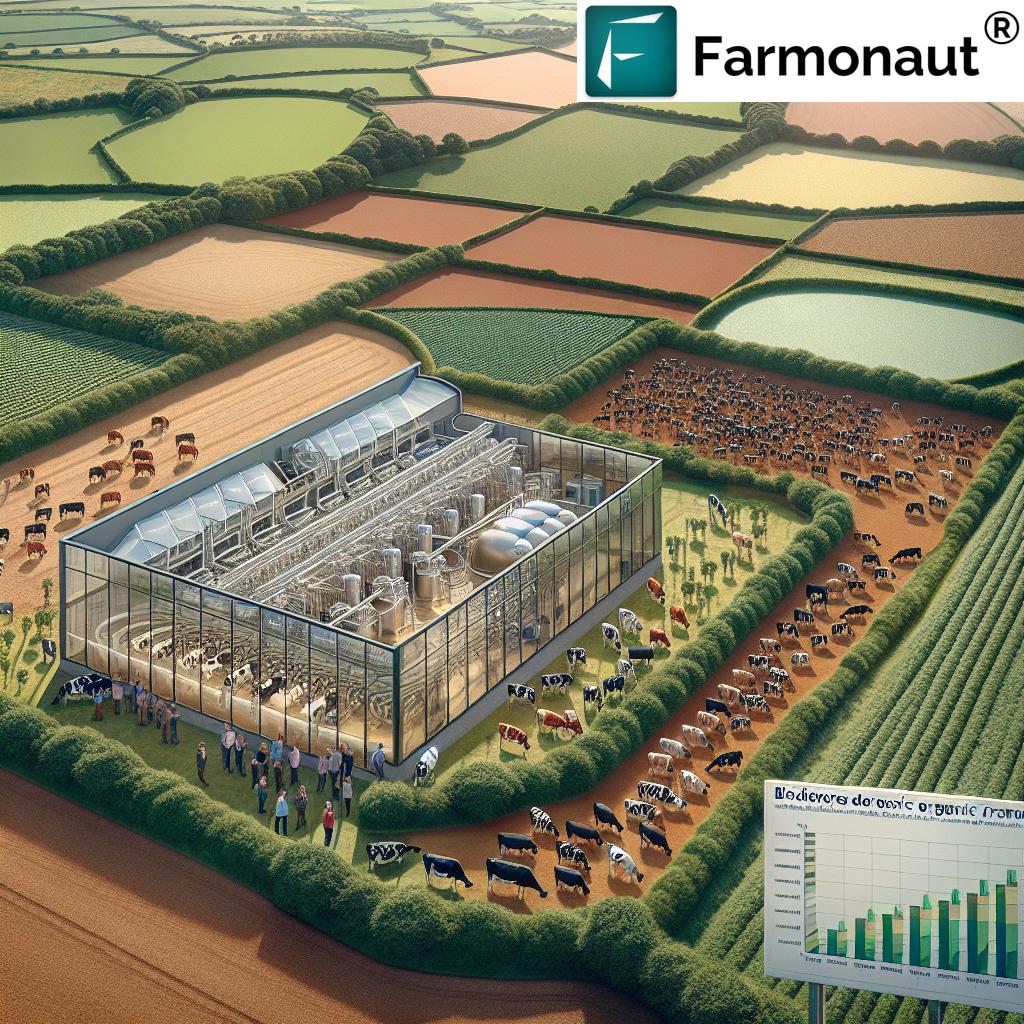UK Organic Dairy Boom: Sustainable Farming Drives 2024 Milk Price Surge
“UK organic milk prices set to reach 56 pence per litre in October 2024, reflecting growing demand for sustainable dairy.”
As we delve into the exciting developments in the UK’s organic dairy sector, we’re witnessing a remarkable shift towards sustainable agriculture practices that are reshaping the industry. The recent announcement of a significant increase in organic milk prices, reaching an impressive 56 pence per litre for October 2024, marks a pivotal moment in the UK dairy market trends. This surge not only reflects the growing demand for organic products but also highlights the industry’s commitment to farmer-friendly models and long-term stability.
In this comprehensive exploration of the UK organic dairy boom, we’ll examine the factors driving this price surge, the implications for farmers and consumers, and how innovative technologies like those offered by Farmonaut are revolutionizing organic dairy farming. Let’s dive into the heart of this sustainable revolution and discover how it’s shaping the future of British agriculture.
The Rise of Organic Dairy Farming in the UK
The organic dairy sector in the UK has been gaining momentum in recent years, driven by several key factors:
- Increasing consumer awareness of the benefits of organic products
- Growing concerns about environmental sustainability
- A shift towards healthier and more ethical food choices
- Support from farmer-owned cooperatives and industry initiatives
These elements have converged to create a favorable environment for organic dairy farming, leading to the current boom we’re witnessing in the sector.

Understanding the 2024 Milk Price Surge
The announcement of organic milk prices reaching 56 pence per litre for October 2024 is a significant milestone for the industry. This price increase reflects several important factors:
- Growing Demand: Consumer demand for British organic dairy products continues to rise, driving up prices.
- Sustainable Practices: The higher price acknowledges the additional costs and efforts associated with organic farming methods.
- Farmer Support: It represents a commitment to providing stable financial returns to farmers, encouraging more to transition to organic practices.
- Market Recognition: The price surge indicates that the market is increasingly valuing the quality and ethical standards of organic dairy.
To better understand the context of this price increase, let’s look at the trends over the past few years:
| Year | Average Organic Milk Price (pence per litre) | Year-over-Year Change (%) | Key Market Drivers |
|---|---|---|---|
| 2022 | 45.2 | – | Post-pandemic recovery, sustainable farming initiatives |
| 2023 | 49.8 | +10.2% | Increased consumer awareness, supply chain improvements |
| 2024 | 56.0 | +12.4% | Growing consumer demand, sustainable farming practices, cooperative support |
This table clearly illustrates the significant jump in organic milk prices, particularly the notable increase projected for 2024. The consistent year-over-year growth underscores the sector’s positive outlook and the increasing value placed on organic dairy products.
The Role of Farmer-Owned Cooperatives
One of the key drivers behind the organic dairy boom is the support provided by farmer-owned cooperatives. These organizations play a crucial role in:
- Negotiating favorable prices for their members
- Providing resources and support for farmers transitioning to organic practices
- Ensuring a stable market for organic milk products
- Promoting sustainable agriculture practices across the industry
The recent price announcement by a prominent farmer-owned cooperative is a testament to the strength and influence of these organizations in shaping the future of the UK dairy market.
Geographical Spread of the Organic Dairy Boom
“The UK organic dairy boom spans multiple regions, including Scotland and Southwest England, indicating a widespread industry shift.”
The organic dairy boom is not limited to a single region but is spreading across various parts of the UK. Notable areas experiencing growth include:
- Scotland: Known for its lush pastures and traditional farming practices, Scotland is seeing a surge in organic dairy conversions.
- Southwest England: This region, with its favorable climate for grazing, is becoming a hub for organic dairy farming.
- Wales: With its strong agricultural heritage, Wales is also embracing the organic dairy movement.
- Northern Ireland: Farmers here are increasingly recognizing the benefits of organic dairy production.
This widespread adoption across different regions highlights the universal appeal and potential of organic dairy farming in the UK.
Transitioning to Organic Farming: Challenges and Opportunities
While the price surge is encouraging more farmers to consider transitioning to organic dairy farming, this process comes with both challenges and opportunities:
Challenges:
- Initial investment in infrastructure and land management
- Strict certification requirements and regulations
- Potential yield reduction during the transition period
- Need for specialized knowledge and skills in organic farming practices
Opportunities:
- Higher milk prices and stable returns
- Improved soil health and biodiversity on the farm
- Reduced dependency on external inputs like synthetic fertilizers and pesticides
- Potential for diversification into value-added organic products
To support farmers in this transition, various resources and support systems are available, including guidance from agricultural extension services, organic farming associations, and technological solutions like those offered by Farmonaut.

The Impact of Technology on Organic Dairy Farming
As the organic dairy sector grows, technology is playing an increasingly important role in enhancing productivity and sustainability. Precision agriculture solutions, like those provided by Farmonaut, are revolutionizing the way organic dairy farms operate.
Key technological advancements include:
- Satellite-Based Crop Health Monitoring: Allows farmers to optimize pasture management and feed production.
- AI-Driven Advisory Systems: Provide personalized recommendations for herd management and farm operations.
- Blockchain-Based Traceability: Ensures transparency in the organic dairy supply chain, boosting consumer trust.
- Resource Management Tools: Help farmers optimize water usage, energy consumption, and other resources.
These technologies not only improve farm efficiency but also support the core principles of organic farming by promoting sustainable practices and reducing environmental impact.
Consumer Trends Driving the Organic Dairy Market
The surge in organic milk prices is closely tied to evolving consumer preferences. Key trends include:
- Health Consciousness: Consumers are increasingly seeking out organic products for their perceived health benefits.
- Environmental Awareness: Growing concern about climate change is driving demand for sustainably produced food.
- Animal Welfare: Consumers are more interested in how animals are treated in food production.
- Local and Traceable Products: There’s a growing preference for British-produced dairy with clear origins.
These trends are not only driving up demand for organic dairy but also influencing how dairy farms operate and market their products.
The Role of Policy in Supporting Organic Dairy
Government policies play a crucial role in shaping the organic dairy sector. Key policy areas include:
- Subsidies and Grants: Financial support for farmers transitioning to organic practices.
- Regulatory Framework: Setting and enforcing standards for organic certification.
- Research and Development: Funding for innovation in sustainable farming techniques.
- Trade Agreements: Ensuring favorable conditions for British organic dairy exports.
These policies are crucial in creating a supportive environment for the growth of the organic dairy sector and ensuring its long-term sustainability.
The Future of UK Organic Dairy: Predictions and Trends
As we look towards the future of the UK organic dairy sector, several trends and predictions emerge:
- Continued Price Growth: The upward trend in organic milk prices is likely to continue, reflecting ongoing demand and value recognition.
- Technological Integration: Increased adoption of precision agriculture tools and AI-driven solutions in organic dairy farming.
- Diversification: More organic dairy farms may diversify into value-added products like artisanal cheeses and yogurts.
- Sustainability Focus: Enhanced emphasis on carbon-neutral and regenerative farming practices within the organic dairy sector.
- Consumer Education: Greater efforts to educate consumers about the benefits of organic dairy, further driving demand.
These trends suggest a bright future for UK organic dairy, with opportunities for growth, innovation, and increased sustainability.
How Farmonaut is Supporting the Organic Dairy Boom
Farmonaut’s precision agriculture solutions are particularly well-suited to support the growth of the organic dairy sector. Our technologies offer several key benefits:
- Optimized Pasture Management: Our satellite-based crop health monitoring helps farmers maintain healthy, productive grazing lands.
- Efficient Resource Use: Our AI-driven advisory system helps farmers make data-informed decisions about water usage, feed management, and more.
- Traceability: Our blockchain-based solutions support the transparency that’s crucial in the organic market.
- Sustainability Tracking: Our carbon footprinting tools help farms monitor and reduce their environmental impact.
By leveraging these technologies, organic dairy farmers can enhance their productivity, sustainability, and profitability in line with the sector’s growth.
Explore Farmonaut’s solutions:
Conclusion: A Sustainable Future for UK Dairy
The UK organic dairy boom, marked by the significant price surge to 56 pence per litre for October 2024, represents a pivotal moment in the industry. This trend reflects not just growing consumer demand but a broader shift towards sustainable agriculture practices and farmer-friendly business models.
As we’ve explored, this boom is driven by a combination of factors including consumer preferences, technological advancements, supportive policies, and the efforts of farmer-owned cooperatives. The widespread nature of this trend, spanning regions from Scotland to Southwest England, indicates a comprehensive transformation of the UK dairy sector.
While challenges remain in transitioning to organic farming, the opportunities for improved sustainability, profitability, and market stability are significant. Technologies like those offered by Farmonaut are playing a crucial role in supporting this transition, helping farmers optimize their operations and meet the growing demand for organic dairy products.
As we look to the future, the UK organic dairy sector appears poised for continued growth and innovation. By embracing sustainable practices, leveraging technology, and responding to consumer demands, the industry is not just adapting to change but actively shaping a more sustainable and prosperous future for British agriculture.
FAQs
- Q: What is driving the increase in organic milk prices in the UK?
A: The price increase is driven by growing consumer demand for sustainable and organic products, increased recognition of the value of organic farming practices, and efforts by farmer-owned cooperatives to ensure stable returns for farmers. - Q: How does organic dairy farming differ from conventional dairy farming?
A: Organic dairy farming adheres to strict standards that prohibit the use of synthetic pesticides, fertilizers, and antibiotics. It emphasizes animal welfare, sustainable land management, and natural feeding practices. - Q: What challenges do farmers face when transitioning to organic dairy production?
A: Challenges include initial investments in infrastructure, potential yield reductions during the transition period, strict certification requirements, and the need to acquire specialized knowledge in organic farming practices. - Q: How is technology helping organic dairy farmers?
A: Technologies like satellite-based crop monitoring, AI-driven advisory systems, and blockchain-based traceability are helping farmers optimize their operations, improve sustainability, and enhance transparency in the supply chain. - Q: What is the outlook for the UK organic dairy sector in the coming years?
A: The outlook is positive, with expectations of continued price growth, increased technological integration, diversification into value-added products, and a stronger focus on sustainability and regenerative farming practices.






